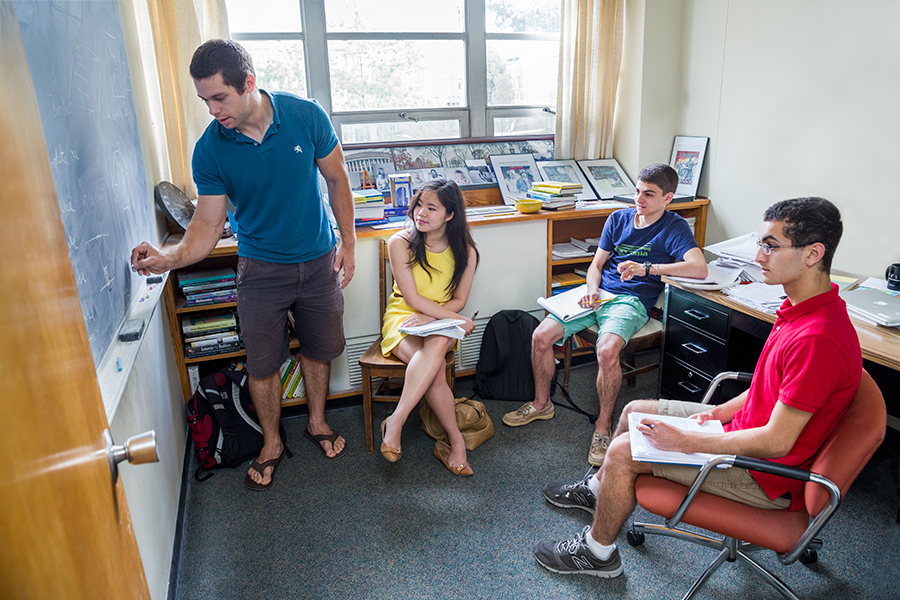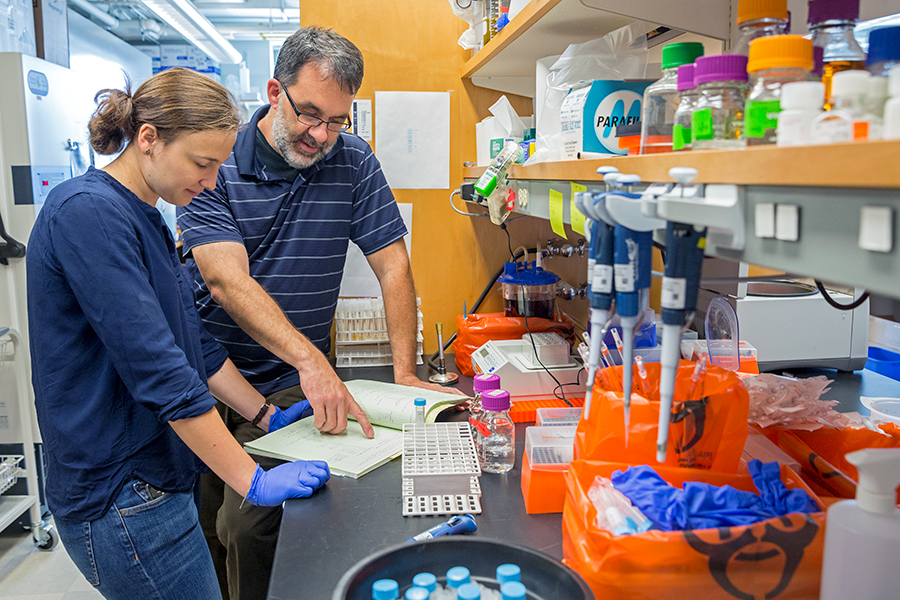Published: September 2014
k
In 1997, the University created the undergraduate research fellowship program to support student involvement in faculty research projects. This past summer, 171 rising sophomores, juniors, and seniors were engaged in studies conducted in 16 departments in the College of Arts and Sciences. A sampling follows.
Photographs by Caitlin Cunningham
Erik Liu ’17 (left) with associate professor of chemistry Dunwei Wang in Wang’s Merkert Chemistry Center laboratory.
For a project related to artificial photosynthesis, says Wang, Liu has been attempting “to take nanoparticles of Fe2O3 (rust) and make them into electrodes that can directly harvest solar energy.” The energy, says Wang, will be used “to power chemical reactions such as water splitting, which produces hydrogen as a clean energy carrier.” Here, they are inspecting electrodes that have been grown in an iron-based solution.
Grace Lisius ’16 (with clipboard) and Gabrielle David, visiting assistant professor of earth and environmental sciences, on the banks of the Souhegan River in Merrimack, New Hampshire.
Lisius and David are studying riparian vegetation as part of a project by Noah Snyder, associate professor of earth and environmental sciences, to assess effects of the 2008 removal of the Merrimack Village Dam. Here, they record plant diversity within a one-by-one-meter frame.
From left, psychology Ph.D. candidate Lauren Anderson, Anna Whitham ’15, and associate professor of psychology Gorica Petrovich in Petrovich’s Higgins Hall laboratory.
In Petrovich’s lab, gender-related differences have been found in rodents’ ability to remember signals for food. According to Whitham, she has been investigating with Anderson “the effect of different estrogen levels on the ability of rats—male and female alike—to remember that certain cues signal food in certain contexts.”
From left, assistant professor of mathematics John Baldwin, Cynthia Chen ’17, Champ Davis ’17, and Andrew Araghi ’16 in Baldwin’s Carney Hall office.
“Andrew, Champ, and Cynthia’s project,” says Baldwin, ”is to study certain aspects of Khovanov homology,” which, he explains, is “a powerful knot invariant [that] has received a tremendous amount of interest” for its “surprising connections between seemingly disparate mathematical fields.” The students’ responsibilities include, Baldwin says, “writing a computer program to compute a certain ‘module structure’ on Khovanov homology.” The structure, he says, “has proven useful in studying knots but has not yet been investigated thoroughly.”
Logan Wren ’15 with assistant professor of classical studies Gail Hoffman in the department’s research cubicle in Stokes Hall.
In February 2015, the McMullen Museum will open the exhibition Roman in the Provinces: Art on the Periphery of Empire, a show Hoffman co-organized with Lisa Brody of the Yale University Art Gallery. Wren worked with Hoffman to produce an accompanying, eponymous book of scholarly essays, “copy editing, fact-checking, and indexing” the text, says Hoffman. He also helped prepare teaching materials for the exhibition. Here the two look at the finished book.
Emily Vasiliou ’16 with associate professor of political science Jonathan Laurence in his McGuinn Hall office.
For Laurence’s forthcoming book comparing the institutional development of Ottoman Islam and Roman Catholicism, says Vasiliou, “I did a lot of research on the Ottoman Empire, the influence of the Islamic state, and recent protests in the Middle East,” as well as on “current Middle Eastern leaders.”
Allyson Tank ’15 with associate professor of biology Welkin Johnson in Johnson’s Higgins Hall laboratory.
“I have been investigating ABOBEC3F, a protein that defends a host from retroviral infection” apparently by causing the virus’s DNA to mutate, says Tank, in an email. “Retroviruses have evolved the protein Vif to counteract the actions of APOBEC,” she continues, and, with Johnson, she has been looking at how different formations of ABOBEC3F affect its “sensitivity” to certain simian immunodeficiency viruses.







